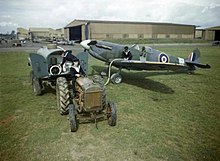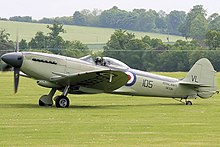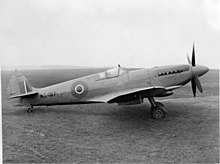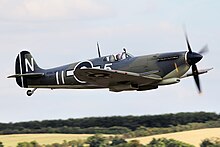761 Naval Air Squadron
| 761 Naval Air Squadron | |
|---|---|
| Active | 1 August 1941 - 16 January 1946[1] |
| Country | |
| Branch | |
| Type | Fleet Air Arm Second Line Squadron |
| Role | Naval Air Fighter School |
| Size | Squadron |
| Part of | Fleet Air Arm |
| Garrison/HQ | RNAS Yeovilton (HMS Heron) RNAS Henstridge (HMS Dipper) |
| Commanders | |
| Notable commanders | Lieutenant Commander Richard John Cork, DSO, DSC Commander Stanley Gordon Orr, DSC & Two Bars, AFC |
| Insignia | |
| Identification Markings | unknown (All types 1941 - 1942) G1A+ to G6A+ (All types 1943)[2] |

761 Naval Air Squadron (761 NAS) was a Naval Air Squadron of the Royal Navy's Fleet Air Arm. It was formed at HMS Heron, RNAS Yeovilton, as the Advanced Training Squadron of the Fleet Fighter School, in 1941. The squadron moved to HMS Dipper, RNAS Henstridge, in 1943, as part of the No. 2 Naval Air Fighter School. It remained at HMS Dipper and in this role, until January 1946, when the squadron disbanded.
History of 761 NAS
[edit]Naval Air Fighter School (1941–1946)
[edit]761 Naval Air Squadron formed, on 1 August 1941, at RNAS Yeovilton (HMS Heron) near Yeovil, Somerset.[3] It was formed out of 760 Naval Air Squadron's Fairey Fulmar, a carrier-based reconnaissance/fighter aircraft and tasked as the Advanced Training Squadron of the Fleet Fighter School, and it used RNAS Haldon (HMS Heron II) for air firing practice.[4] During 1942, Blackburn Roc, a carrier-based turret fighter aircraft and Supermarine Spitfire I, a single-seat fighter aircraft, were received by the squadron.[2]

On 10 April 1943, 761 Naval Air Squadron relocated to RNAS Henstridge (HMS Dipper), situated near Henstridge, in Somerset, as part of No.2 Naval Air Fighter School. At this point, the squadron was equipped with a mix of eighteen Supermarine Spitfire and Supermarine Seafire, the latter a navalised Spitfire fighter aircraft, along with six Miles Master, an advanced trainer aircraft.[5]
Utilising 'D' Flight, trainees went about real deck landing training on the Attacker-class escort carrier, HMS Ravager, and the aircraft carrier, (converted from an ocean liner), HMS Argus.[2] Supermarine Seafire was the main aircraft operated by the squadron and by June 1944, sixty-eight Supermarine Seafire fighter aircraft were being used, consisting various marks.[4]
761 Naval Air Squadron disbanded at RNAS Henstridge (HMS Dipper) on 16 January 1946.[5]
Aircraft operated
[edit]The squadron has operated a number of different aircraft types, including:[3][2]


- Fairey Fulmar Mk.I reconnaissance/fighter aircraft (August 1941 - April 1943)
- Fairey Fulmar Mk.II reconnaissance/fighter aircraft (August 1941 - April 1943)
- Blackburn Roc I fighter aircraft (April 1942 - July 1942)
- Supermarine Spitfire Mk I fighter aircraft (September 1942 - July 1944)
- Miles Master I advanced trainer (April 1943 - November 1943)
- Miles Master II advanced trainer (April 1943 - January 1946)
- Supermarine Seafire Mk Ib fighter aircraft (April 1943 - March 1945)
- Supermarine Spitfire Mk Va fighter aircraft (April 1943 - January 1945)
- Supermarine Spitfire Mk Vb fighter aircraft (April 1943 - January 1945)
- Supermarine Spitfire Mk Vb "hooked" fighter aircraft (November 1943 - February 1945)
- Supermarine Seafire Mk III fighter aircraft (April 1944 - January 1946)
- Supermarine Seafire F Mk IIc fighter aircraft (July 1944 - August 1945)
- North American Harvard III advanced trainer (November 1944 - January 1946)
- Supermarine Seafire F Mk XV fighter aircraft (July 1945 - January 1946)
- Supermarine Seafire F Mk XVII fighter aircraft (November 1945 - January 1946)
Naval air stations
[edit]761 Naval Air Squadron operated from a couple of naval air stations of the Royal Navy, in England:[3][2]
- Royal Naval Air Station YEOVILTON (HMS Heron) (1 August 1941 - 10 April 1943)
- Royal Naval Air Station HENSTRIDGE (HMS Dipper) (10 April 1943 - 16 January 1946)
- 'D' Flight DLT
- HMS Ravager (1 - 5 May 1944 / 18 - 20 May 1944)
- HMS Argus (26 - 27 August 1944)
- HMS Ravager (27 January - 2 February 1945 / 21 - 22 June 1945 / 18 - 23 August 1945)
- 'D' Flight DLT
- disbanded - (16 January 1946)
Commanding officers
[edit]List of commanding officers of 761 Naval Air Squadron with month and year of appointment:[3][2]
- Lieutenant C.P. Campbell-Horsefall, RN, from 1 August 1941
- Captain R.C. Hay, DSC, RM, from 1 January 1942
- Lieutenant(A) R.B. Pearson, RN, from 21 July 1942
- Lieutenant(A) W.C. Simpson, RNVR, from 12 September 1942
- Lieutenant A.C. Wallace, RN, from October 1942
- not identified, from November 1942
- Lieutenant Commander(A) R.J. Cork, DSO, DSC, RN, from 10 April 1943
- Lieutenant Commander(A) R.H.P. Carver, DSC, RN, from 15 November 1943
- Lieutenant Commander(A) S.G. Orr, DSC & Two Bars, RNVR, from 20 September 1944
- Lieutenant Commander(A) P.N. Charlton, DFC, RN, from 27 April 1946
- disbanded - 16 January 1946
Notes
[edit]- ^ Sturtivant & Ballance 1994, p. 79.
- ^ a b c d e f Ballance 2016, p. 62.
- ^ a b Wragg 2019, p. 127.
References
[edit]- Ballance, Theo (2016). The Squadrons and Units of the Fleet Air Arm. Air-Britain. ISBN 978-0-85130-489-2.
- Sturtivant, R; Ballance, T (1994). The Squadrons of The Fleet Air Arm. Tonbridge, Kent, UK: Air-Britain (Historians) Ltd. ISBN 0-85130-223-8.
- Wragg, David (2019). The Fleet Air Arm Handbook 1939-1945. Cheltenham, Gloucestershire, UK: The History Press. ISBN 978-0-7509-9303-6.
